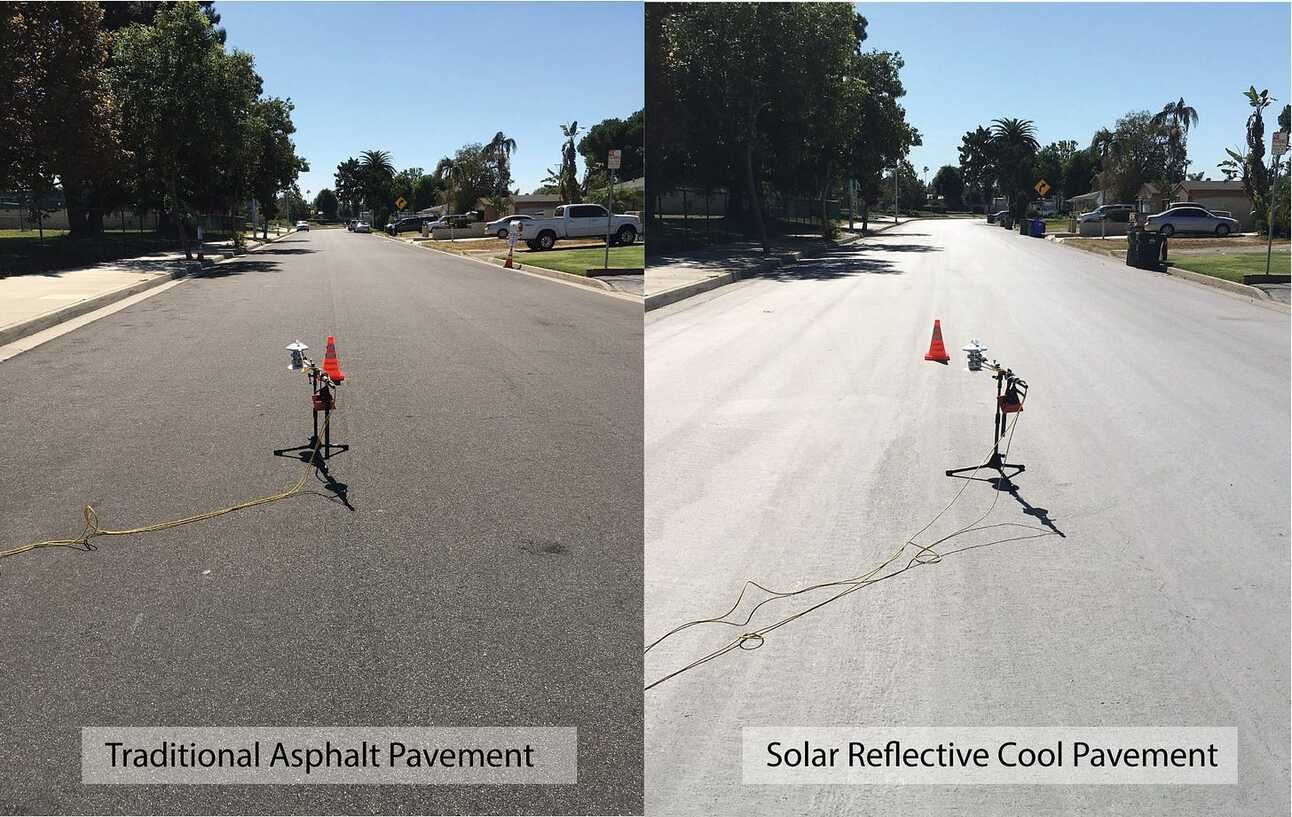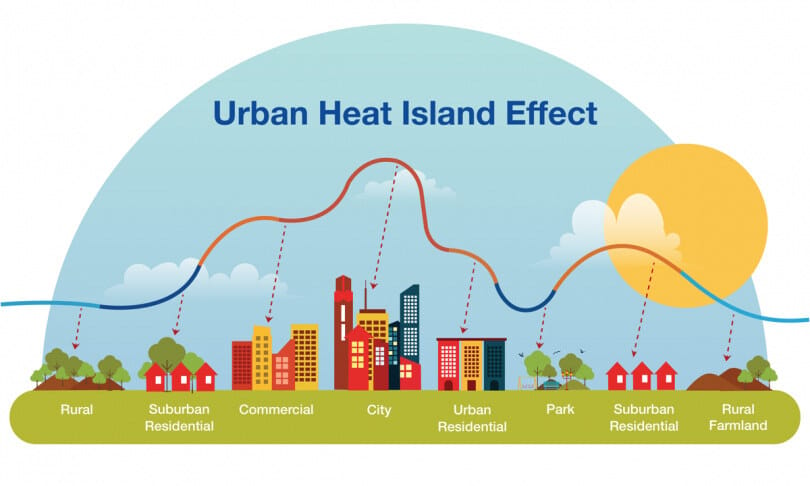Climate change is one of the most pressing issues facing our planet today. The effects of climate change are already being felt worldwide in the form of rising sea levels, more extreme weather events, and changes in plant and animal life.
In the face of escalating climate change, the urgent need for innovative and sustainable solutions has never been more critical. One such solution gaining traction is the implementation of reflective pavements. This unique pavement strategy offers a promising approach to mitigate the urban heat island effect, reduce energy consumption, and combat climate change.
In this blog, we will delve deeper into the concept of reflective pavements, explore their wide-ranging benefits, and discuss their potential as a powerful tool for sustainable urban development.
Reflective pavements are already being used in some cities worldwide, with great success. For instance, in Tokyo, reflective pavements have been used to reduce the urban heat island effect, a phenomenon whereby urban areas are warmer than their rural surroundings. This phenomenon can significantly impact human health, exacerbating heat-related illnesses like heat exhaustion and heat stroke. Reflective pavements are an effective way to combat this problem.
Furthermore, in Los Angeles, reflective pavements have been shown to reduce air temperatures by up to 10 degrees Fahrenheit, which benefits human health and the environment. Additionally, reflective pavements have been implemented in Phoenix, where temperatures regularly reach over 100 degrees Fahrenheit (38 degrees Celsius). Black asphalt used in traditional pavements can reach temperatures between 120-150F (48-67C).
This has increased energy consumption for air conditioning, resulting in higher greenhouse gas emissions. Reflective pavements are a viable solution to reduce the urban heat island effect and mitigate the impacts of climate change.
What is reflective pavement?
Reflective pavements are made cooler by reflecting more of the sun's heat into space. They use special materials and coatings that reflect sunlight. Using lighter colors or reflective coatings, these pavements can help reduce the urban heat island effect and its problems. Reflective pavements have many advantages, such as lowering the temperature, using energy, managing stormwater, improving air quality, and making roads safer.

One way to help fight climate change is to reduce our reliance on fossil fuels. One way to do this is to use reflective pavements. Reflective pavements are made from materials that reflect sunlight, which helps to keep the air cooler. This can lead to several benefits, including:
Reduced energy consumption for air conditioning Reduced greenhouse gas emissions Improved air quality
Reduced heat-related illness Increased safety for pedestrians and cyclists
Understanding the Urban Heat Island Effect
Urban areas are often hotter than rural areas because they absorb and retain more heat than rural areas. This is called the urban heat island effect. Dark surfaces, like asphalt and concrete, absorb and re-emit solar radiation, making the urban heat island effect even more pronounced. Reflective pavements have the potential to help solve this problem and fight climate change.

They work by reflecting sunlight into space instead of absorbing it, resulting in cooler urban areas. However, there are some challenges we need to think about when using reflective pavements. One such challenge is durability - how long will the reflective surfaces last? Another challenge is aesthetics - how will the reflective surfaces look compared to traditional, darker surfaces? Cost is also a factor that needs to be considered.
Reflective pavements may be more expensive initially, but they can save money in the long run by reducing the need for air conditioning and other cooling measures.
Despite these challenges, reflective pavements have the potential to be a great solution for the urban heat island effect and climate change. By addressing durability, aesthetics, and cost, we can ensure that reflective pavements work well and be good for the environment for years.
The Role of Reflective Pavements
Reflective pavements are special surfaces that can help mitigate the urban heat island effect. This phenomenon occurs when cities experience higher temperatures than rural areas due to the heat absorbed by traditional dark-colored pavements, buildings, and other structures. Reflective pavements are usually made of materials that reflect sunlight, such as light-colored concrete, asphalt, or special coatings. By reflecting sunlight, these pavements absorb less heat, which reduces surface temperatures and makes urban areas cooler.
Reflective pavements are a new technology that can help create more sustainable and livable cities. By reducing surface temperatures, energy consumption, and greenhouse gas emissions, these pavements can contribute to mitigating climate change and improving the quality of life for urban residents.
Benefits of Reflective Pavements
Heat Island Mitigation: Urban heat islands are pockets of elevated temperatures in cities, primarily caused by the absorption and re-emission of solar energy by dark surfaces like asphalt. Reflective pavements help counteract this effect by reflecting more sunlight, reducing surface temperatures by 20-45 degrees Fahrenheit compared to conventional pavements.
Temperature Reduction: Reflective pavements can lower surface temperatures than traditional dark pavements. This temperature reduction improves pedestrian comfort, mitigates heat-related illnesses, and decreases the demand for air conditioning, thereby reducing energy consumption.
Energy Efficiency: By diminishing the energy required for cooling buildings, reflective pavements contribute to energy efficiency and help lower greenhouse gas emissions. This energy conservation leads to cost savings for individuals and municipalities while promoting a more sustainable urban infrastructure.
Stormwater Management: Reflective pavements can improve stormwater management. Their increased reflectivity absorbs less heat, resulting in decreased evaporation rates. This, in turn, allows for increased water retention and reduces strain on urban drainage systems during heavy rainfall events.
Improved Air Quality: Reflective pavements indirectly improve air quality. By reducing the urban heat island effect, there is a decrease in the formation of ground-level ozone, a harmful air pollutant that adversely affects respiratory health.
Enhanced Road Safety: Reflective pavements offer improved visibility, particularly during nighttime. The increased contrast between the road surface and lane markings enhances driver perception and reduces the risk of accidents, ultimately enhancing road safety.
Enhanced Pedestrian Comfort: By lowering surface temperatures, reflective pavements create more comfortable conditions for pedestrians, cyclists, and other users of urban spaces. This can encourage active modes of transportation and outdoor activities, promoting a healthier and more sustainable lifestyle.
Challenges and Considerations
While reflective pavements offer numerous benefits, several considerations should be kept in mind:
Longevity and Durability: Planning and implementing reflective pavements requires careful consideration of their long-term performance and durability. Make sure to address maintenance, weathering, and compatibility with existing infrastructure to ensure that they remain effective over time.
Life Cycle Assessment: It's important to evaluate the overall environmental impact of reflective pavements throughout their lifespan. This includes looking at how the materials are made, installed, and disposed of when they're no longer used. By doing this, we can ensure the pavements are environmentally sustainable.
Urban Design and Aesthetics: When designing a city, it's important to consider how the pavement looks. Different people in the city can work together to ensure the pavement looks cool and good. Ensuring the pavement works well and looks good is important to ensure the plan works.
Cost: Installing reflective pavements can be more expensive upfront than traditional pavements. However, the long-term benefits, like saving energy and improving public health, often make up for the initial cost. Also, the cost may decrease as technology improves and more people use them.
Reflective pavements can help combat urban heat islands and create more sustainable and livable cities. They can lower surface temperatures, reduce energy use, improve air quality, and make walking more comfortable. Using reflective pavements should be a priority for urban planning and infrastructure development as we work to address climate change. By making our cities cooler, we can create healthier and more resilient places for future generations.
Several resources are available online to learn more about reflective pavements. You can also contact your local government to see if they are considering using reflective pavements in your community.
Here are some resources to learn more about reflective pavements:
https://www.epa.gov/heatislands/using-cool-pavements-reduce-heat-islands - This website provides information on using cool pavement technologies to reduce the heat island effect and help control stormwater. It covers modeling, design practices, testing, standards development, planning, and policy considerations. It also discusses the benefits and costs of cool pavements, including better nighttime visibility and improved local comfort.
https://www.nature.com/articles/s41467-023-36972-5 - This website provides evidence-based guidance on reflective pavement for urban heat mitigation in Arizona. It evaluates the cooling potential of reflective pavement based on three heat exposure metrics. It provides context-based reflective pavement implementation guidelines to mitigate urban overheating where common strategies cannot be applied.
https://iopscience.iop.org/article/10.1088/1748-9326/ab87d4/meta - This website discusses the benefits and disadvantages of reflective pavement concerning various thermal performance metrics. It provides insights into how cities should weigh the pros and cons of reflective pavement before implementing it.
https://iopscience.iop.org/article/10.1088/1748-9326/ab87d4 - This website presents the first field-based assessment of the heat-mitigating performance of solar reflective coating applied to streets. It discusses the effect of solar reflective coatings on radiant heat, which influences human thermal exposure and comfort.
https://jacobsschool.ucsd.edu/news/release/1281 - This website discusses a study that suggests that some benefits associated with reflective pavements are tied to the environment where they're used. It highlights that pavements designed to fight climate change could increase energy consumption in surrounding buildings.
https://www.fhwa.dot.gov/publications/research/infrastructure/pavements/ltpp/13092/13092.pdf - This website provides a Distress Identification Manual for the Long-Term Pavement Performance Program. It provides a common language for describing cracks, potholes, rutting, spalling, and other pavement distresses being monitored by the LTPP program.